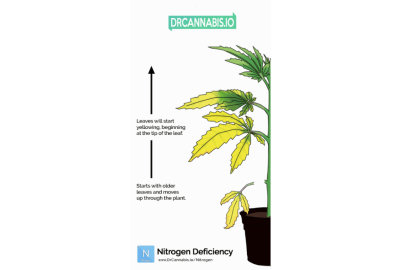Cannabis Leaves Turning Yellow: Causes And Treatments
Have you noticed that your weed plants aren’t thriving; even though you’re giving them the proper care? You may see cannabis leaves turning yellow, but there’s no need to panic. The technical term is chlorosis—chlorophyll deficiency in the foliage.
Your crops are alerting you to the discomfort they’re going through. Take remedial steps to nip the problem in the bud and prevent it from recurring.
As there are several possible causes of the discoloration, it’s vital to identify the symptoms and correctly diagnose the issue. Experimenting with treatment methods to find the right one may lead to further crop damage.
Read on to find out the reasons for your marijuana leaves turning yellow. Learn to spot the signs early and the simple ways to treat their stress.
Diagnosing yellowing leaves on weed plants
Before treating any problem, an accurate diagnosis is critical. Applying the wrong measures may prolong your crops’ struggle and worsen it.
Always check your plants for weed deficiencies, as the issues can stunt growth and lead to lower yields. Bottom weed leaves turning yellow usually indicates a lack of nutrients.
As there are many possible reasons for the problem, let’s look at the common causes of foliage discoloration.
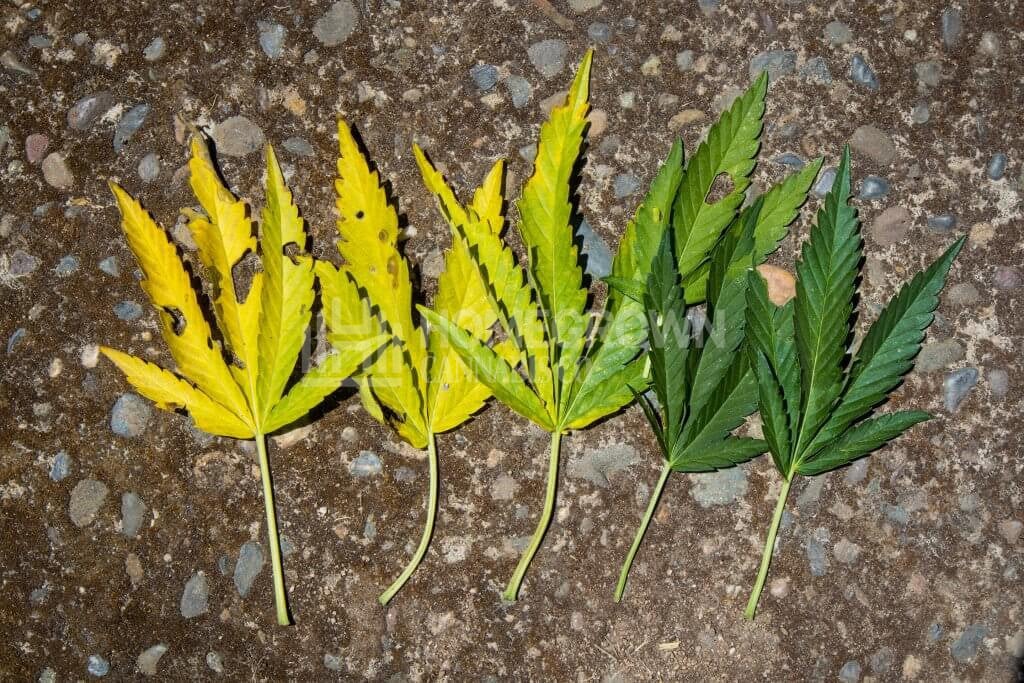
Common causes of cannabis leaves turning yellow
Leaves contain pigments such as green chlorophyll that absorb various light wavelengths. Beneath those are orange and yellow carotenoids.
Chlorophyll is vital as it absorbs sunlight and converts it into energy for plant development through photosynthesis. It thrives when crops have sufficient water and nutrients.
So, why are my marijuana leaves turning yellow? That’s the color of the carotenoids under the chlorophyll that shows when the pigment degenerates. The phenomenon occurs when your cannabis plants experience stress.
It’s critical to address the following possible causes of the problem early, as severe yellowing can stunt crop growth or kill it.
pH imbalance
The first thing to do when you notice cannabis leaves turning yellow is use a test kit to measure your growing medium pH. Its reading mustn't be too low or too high as it blocks nutrient absorption. Weed plants thrive at an optimal level of 6.0–7.0 when grown in the soil and 5.5–6.5 for hydro.
Soil that’s too acidic locks out nutrients like calcium and magnesium as they become less soluble. It also creates a breeding environment for fungal diseases that can cause plant death.
Your marijuana plant struggles to use iron, manganese, copper, zinc, and boron when the medium is in an alkaline state.
In both situations, nutrient lockout results in weed leaves turning yellow.
Implement these methods to adjust the pH level of your growing medium:
- Use chemical pH-up or -down solutions.
- Add organic matter. Limestone or wood ash reduces acidity while sulfur increases it. It takes months to show optimum results, so treat your medium before planting.
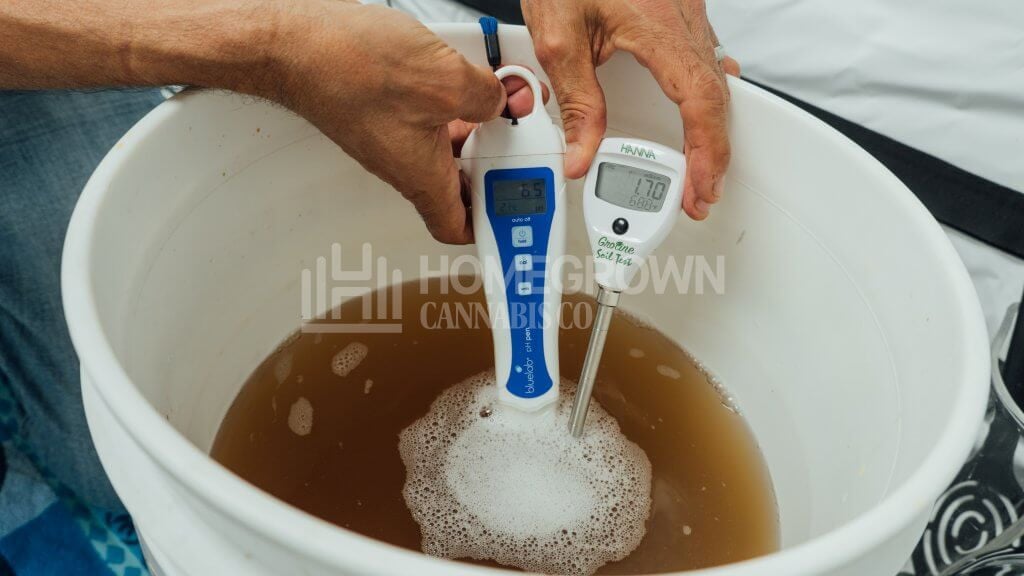
Improper watering
If the problem of marijuana leaves turning yellow persists after gauging and adjusting the pH level for cannabis plants, review your watering routine.
An imbalance in the amount of hydration you provide—over- and under-watering—can lead to foliage discoloration. Although H2O is life for crops, more moisture doesn’t necessarily stimulate growth. Your vegetation may experience adverse effects.
Wet soil may stunt your weed plants’ development and possibly kill them. When the soil is soggy, roots may suffocate and can’t deliver nutrients to the shrub. The foliage turns dark green and curls and bends downwards like claws. Lack of moisture causes leaves to become pale and wilt.
Test your medium daily to avoid cannabis leaves turning yellow due to improper watering. When using soil, test it by poking your index finger about 2 inches deep. Alternatively, insert a humidity meter into the pot. If it’s dry, it’s time to hydrate.
If you’re growing in hydroponics, ensure you correctly set up your pumps, reservoirs, and timers to avoid potential issues.
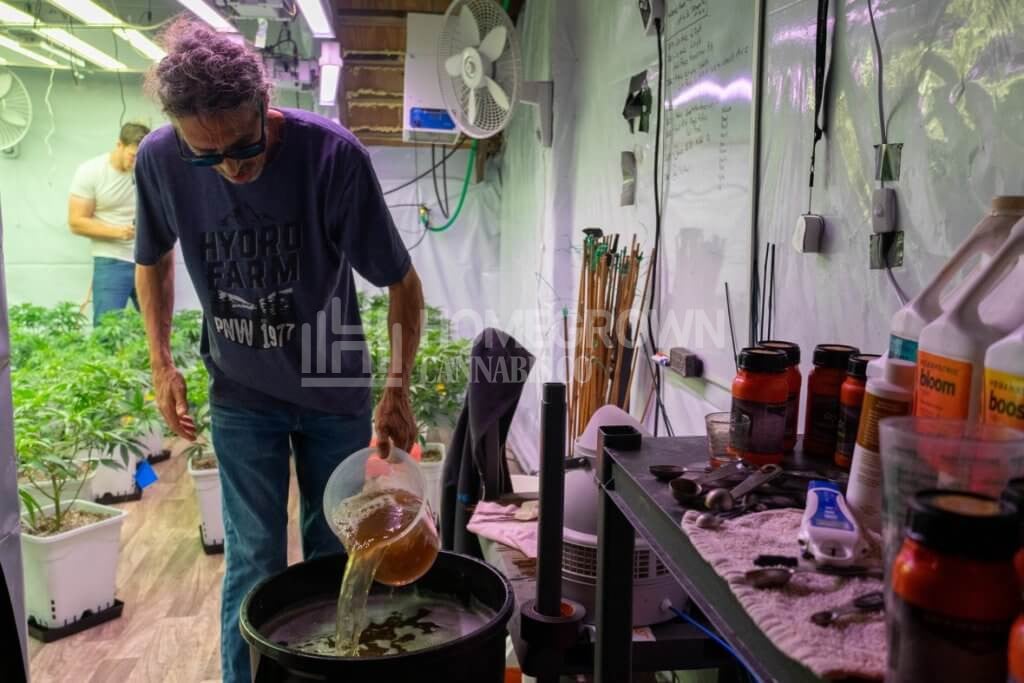
Nutrient deficiencies
After checking and treating sub-optimal growing medium pH and implementing a proper watering schedule, look at how much fertilizer you use. A yellow weed leaf indicates that you may be under-feeding your marijuana plants.
Such foliage discoloration might signal the onset of a nutrient deficiency problem. Many growers are familiar with plants lacking nitrogen (N) or iron (Fe).
When you see that tips of new growth are turning yellow, your crops aren’t getting enough N rather than Fe. The older leaves stay bright green.
Treating a deficiency is simple. Up your feeding, but do it gradually as excess fertilizer can lead to nutrient burn. Keep increasing the dosage until you see signs of recovery.
Yellow cannabis leaves are also symptoms of overfeeding. Flush the roots with pure water before adding nutrients, starting with a lower amount than recommended by the manufacturer to avoid nute burn.
Light burn
If you’re using indoor weed seeds, ensure that your grow lamps aren’t too close to your crops. Light burn—yellowing of leaves close to the top of the shrub—may occur due to the intense heat from the bulbs.
Leaf tips turning yellow may be signs of scorching. Solve the problem by shifting your plants further away from the lighting.
Prevent the issue when setting up your indoor garden by positioning your grow lights according to the manufacturer’s instructions. Use a tape measure to determine the distance between them and the canopy. Adjust the height as your plants develop.
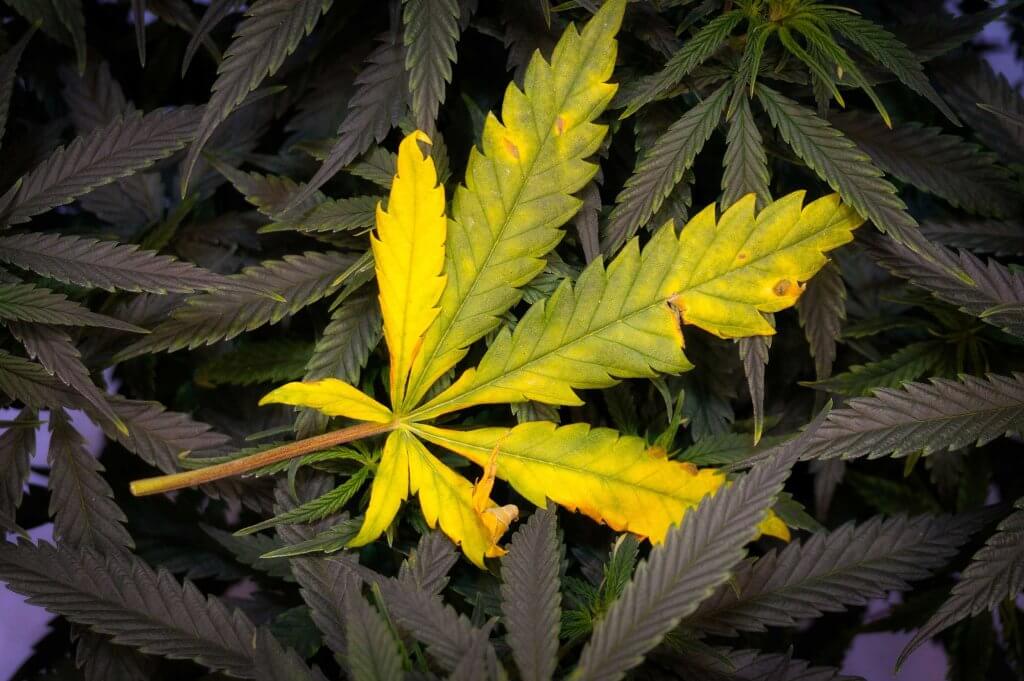
Temperature
The ideal temperature for weed is 70°F–80°F. Yellowing leaves on a weed plant might occur when conditions are outside that range.
The symptoms usually appear in cold environments below 50°F. Some foliage may turn purple and bluish. Increase the heat in your indoor garden or add more grow lamps. If your pots are on a cement floor, place them on a platform to keep them off the ground.
When the temperature exceeds 82°F, yellow leaves on weed plants appear as they can’t photosynthesize efficiently. Ensure your air conditioning unit is strong enough to cool the room.
If you grow outdoor cannabis seeds, bring your plants inside at night or use a greenhouse when the weather is cold. During a hot climate, keep your crops in the shade.
Pests and bugs
Another possible answer to the question, why are my weed leaves turning yellow? is pest infestation. An indication that you have an insect problem is that besides discoloration, the foliage also shows bite marks or spots. You might notice your crops lacking energy as well.
Thrips typically attack cannabis plants in large groups. They cause damage by scraping the leaves, flowers, and fruit and sucking the juices. These insects thrive in dry and hot conditions, such as in the western parts of the United States.
Solving the problem of yellow leaves on a cannabis plant due to pests can be challenging. Avoid bringing outdoor shrubs or clones into a hygienic grow area to prevent it from happening. Before entering your indoor garden, wash your hands and cover your hair. Don’t allow pets inside.
Introduce predatory insects to defend your weed crops against harmful species. Cultivating plants that repel the pests also helps. If you detect eggs, use a foliar spray to decontaminate the vegetation.
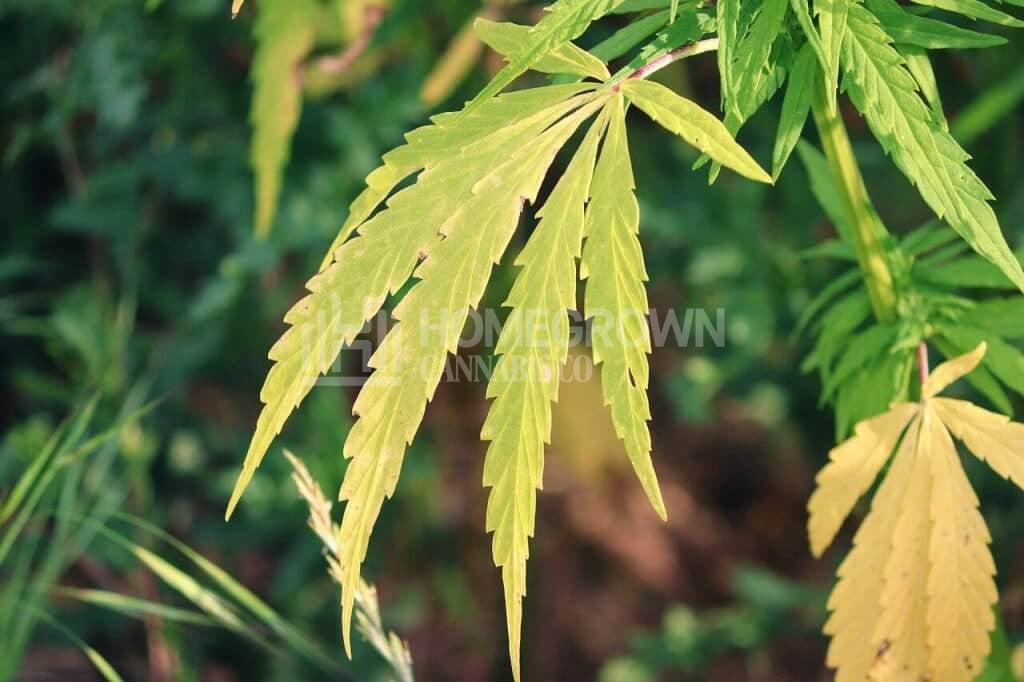
Weed plant infected with leaf Septoria
Fan leaves turning yellow during veg may indicate a disease. A common culprit is a fungus—Septoria lycopersici—which quickly spreads from an affected leaf to other foliage.
The initial signs of the fungal infection are black spots with a yellow outer hue on older leaves close to the plant’s base. The symptoms differ from a nutrient deficiency, in which you might see yellow tips on weed leaves.
To treat the problem, cut away foliage showing symptoms of leaf septoria using a clean pair of pruning scissors. Remove all infected leaves and debris to prevent the disease from spreading. Adding fresh mulch stops the spores from getting into the soil.
End the treatment by applying a foliar spray containing neem oil to cleanse unseen traces of the fungi.
Pay attention to cannabis seedling yellowing to nip the problem before it worsens. If your crops lose a lot of foliage necessary for photosynthesis, they won’t develop healthily and produce large yields.
As Septoria lycopersici thrives in humid conditions, ensure your growing space has proper ventilation. Fans help to improve airflow and if the area gets too damp, install a dehumidifier. If you cultivate outdoors, expose your plants to the wind by placing the pots on higher ground.
Root rot
Root rot occurs when certain organisms attack vulnerable parts of the system, causing water and nutrient absorption issues. These fungi and pathogens breed in wet soil, and yellow leaves on weed plants appear when they strike. Notice also that plants begin to look withered.
Deal with root rot using the following methods:
- Introducing beneficial microorganisms into the ground, such as mycorrhizal fungi.
- Modify your watering schedule. Discontinue watering and check the soil. Hydrate only if you insert your finger two inches deep, and it’s dry.
- Transfer affected plants into fabric containers or use an Air-Pot system to improve aeration and drainage.
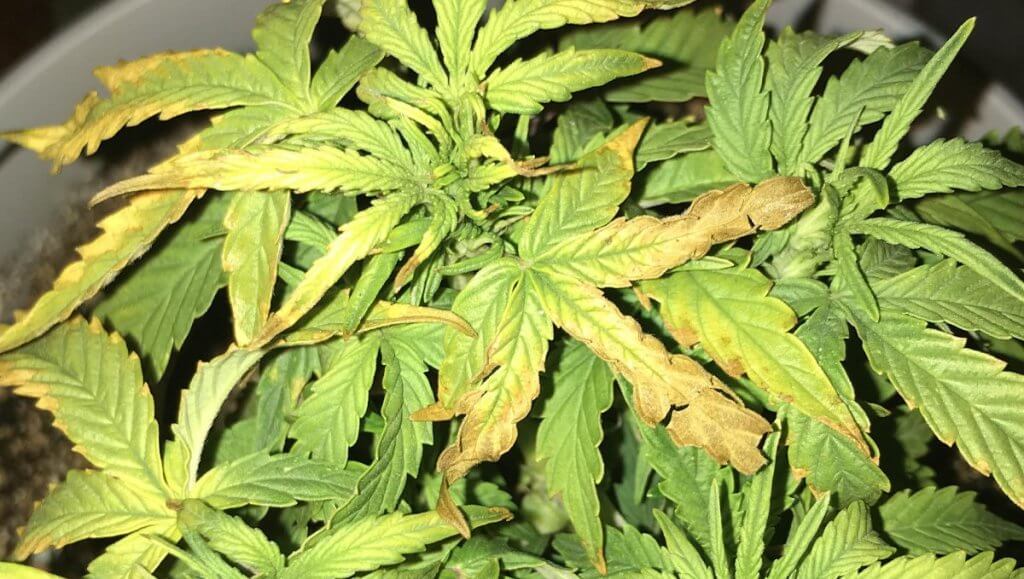
Natural processes of yellowing weed leaves
Yellow leaves on marijuana don’t always signify a disease or nutrient deficiency. They could naturally occur as part of their life cycle.
Foliage discolors due to age before it falls off. Yellowing also happens during the flowering stage when your cannabis plants channel energy away from the leaves to produce buds.
Some growers flush nutrients as harvest time approaches to enhance nug flavor. This measure also causes yellowing and leaves falling off.
FAQs about marijuana leaves turning yellow
In this section, our experts provide more answers to the question, why are the tips of my weed plants turning yellow?
Why are my weed leaves turning yellow?
Foliage discoloration may result from several causes, including:
- An overly acidic or alkaline growing medium
- Overwatering
- Temperatures outside the optimal 70°–80°F
- Nutrient deficiencies
- Light burn
- Pest infestation
- Fungal diseases, such as leaf septoria
- Root rot
Should I be worried when cannabis leaves become yellow?
No, there’s no reason to worry about yellowing foliage if you catch the problem early and treat it immediately. However, you risk the condition harming or possibly killing your cannabis plants if you don’t correctly diagnose the issue or leave it untreated.
Do yellow leaves appear only on mature weed plants?
No, it’s not only mature leaves that discolor. You may notice weed seedlings turning yellow as some triggers affect your cannabis plant at an early stage of its growth.
Nitrogen deficiency, for instance, causes yellowing, especially during vegetation, as that’s when your crops need it most.
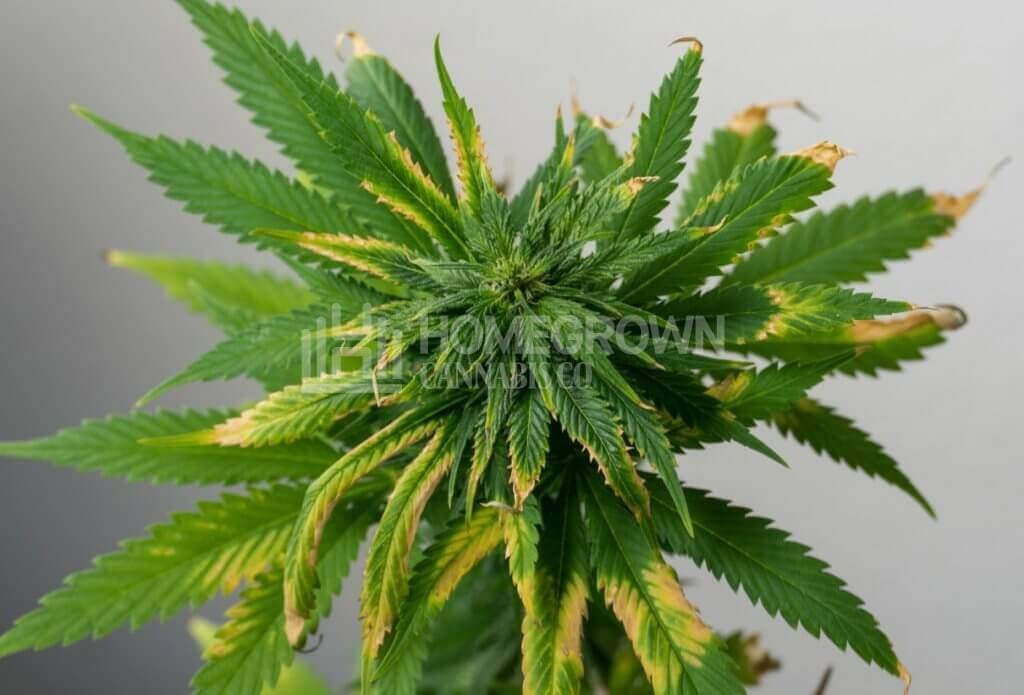
Yellow cannabis leaves are symptoms, not problems
Seeing your weed plants’ green foliage turning yellow may be scary, but there’s no reason to worry. It’s vital to recognize that the discoloration and your cannabis leaves turning yellow aren’t a problem but your crops’ way of alerting you to the stress they’re experiencing.
By taking proactive measures, it’s possible to reduce several of the risks. Be vigilant throughout the growth process to identify issues and implement immediate remedial action. Prompt treatment helps your plants recover, develop, and produce abundant yields.
Minimize problems by using quality seeds that grow into robust crops, less susceptible to threats like pests and diseases. Visit our website and check out our seed collection that includes hard-to-find strains. Get more cultivation tips from our experts too at our blogs section.
About the author: Derek LaRose
Also known as Kronic from The Cannabis Kronicles, Derek LaRose is a young ambitious cultivator and a staple educator for indoor cultivation.
